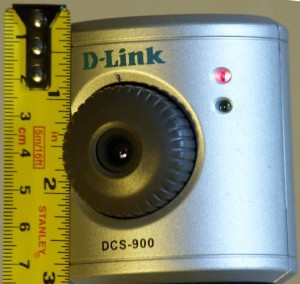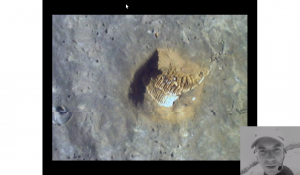Since ERA already has some IP cameras from previous years, it’s probably time to dust them off and try them out with the new Asus 901s. We have a pair of D-Link badged items – a DCS-900 wired-only Motion-JPEG camera with a maximum resolution of 640×480 pixels, and a much fancier DCS-3220g which has 802.11g WiFi as well as wired ethernet, full PAL -sized MPEG-4 as well as Motion-JPEG output, sound support via an internal mic and line output socket and an interchangeable CS-mount lens. Continue reading
Tag Archives: vowlan
Sipdroid works on G1 Android 1.5
Good news sipdroid works with our Asterisk server. Following up on a lead I received from Ben Charlton at the JISCRI developers workshop last week, I tried running sipdroid on a borrowed G1 Android phone (big thanks to Paul Hogan). The default SipDroid pretty much works, but you need to set the nat setting in the Asterisk sip.conf file to yes (see sipdroid website – issue 15). No big deal but SipDroid does not authetnticate without it.
Once I got over the above registration issue, it was just a case of setting the Asterisk audio codecs to include alaw. Seems pretty OK – supports a steady audio stream. We could use this with a separate webpage displayed on the phone web browser for showing images and the video stream. Currently the SipDroid does not display a remote video and I was unable to get it to stream video from the phone within SipDroid, but audio is certainly doable.
Using smartphones as …phones.
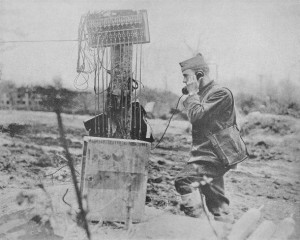
An early outdoor phone exchange
Could it be that the way to make a telephone call on a geology site would be to use a telephone? Now we seem to have some fairly stable WiFi networking hardware, and are considering that we might ditch the awkward netbooks for our ‘Sherpas’ in the field, perhaps we could use WiFi equipped smartphones for some of our outdoor networking needs?
Since we’re using SIP, we’ll need SIP software for any mobile phones we use, and there are obvious commercial reasons why most mobile service providers aren’t keen on this, but on the up side, bluetooth headsets are designed to be used with mobile phones so this could add another useful feature to the ERA toolkit.
Googlemaps links
Some annotated maps of our adventures on the North East coast :
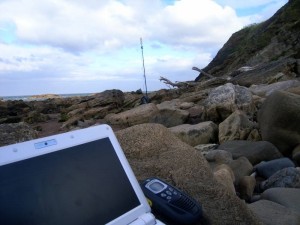
ERA kit on the beach at Scremerston
Seaton Sluice – visited on 01/08/09
Hartley Bay – visited on 01/08/09
Scremerston – visited on 04/08/09
Saltwick Bay – visited on 05/08/09
Howick – Rumbling Kern and Howick Haven, visited on 07/08/09.
Durham field tests
The ERA team has just returned from a week-long field trip in the North East of England, based at Durham University. We did tests at locations related to OU Geology module SXR369 along the Northumberland coastline. We trialled new (to us) VoIP services including 2-way video with a view to assisting students with limited mobility to experience geological fieldwork alongside their more mobile peers. Expect to see some news and test results here in the next few days.
The curse of ERA strikes again! (sunshine :-) )
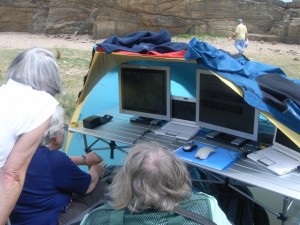
Tutor and students at the ERA base location viewing the video feed and communicating via VoIP with the field geologist. Howick, Friday 07 August 2009
The curse of ERA – bringing sunny weather to field trips – strikes again! Despite packing gaiters, gortex, and waterproof sample bags to protect our kit, it was the sunshine rather than the rain that was the challenging weather for the Durham area field trips.
Jokes aside, we’ve had great weather, mainly sunny with the occasional light smattering of rain. This is actually a significant factor for us when we’re working in the field. The radio signal isn’t affected by rain to any great degree, we’re fairly confident that students will dive for cover before the radio signal deteriorates too far in rainy conditions, but we have to watch out for sun and rain when it comes to using the equipment in the field.
We’re aiming to use off-the-shelf, consumer equipment as much as possible so as to come up with a solution that could be taken up by the greatest number of other educational institutions. There is heavily ruggedised military-specification equipment for most of what we’re doing but the cost and weight factors puts this out of our league and probably would make the ERA system much less likely to be adopted by a broad community of users. Continue reading
Thursday: Configuration and Demonstration
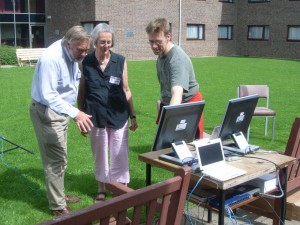
Mark demonstrating the ERA system to Bob and Di, tutors for students with additional requirements at the OU geology residential school
Today we had a morning checking over kit, and trying out further configurations. One of the benefits of working alongside an Open University residential school is that we’re getting to visit a lot of authentic field sites and trying out different configurations in quite an intense schedule. So this morning we dedicated some time to documenting where we’d got to and trying some new configurations.
Another great aspect of the residential school is that we get to spend some time with tutors and students and are offered valuable insights into what their learning and teaching goals are. This year, two of the tutors (Bob and Di) working with the Additional Requirements students have kindly agreed to try out the system with a selection of their students on Friday. So the afternoon is spent setting up and running a small demonstration with Bob and Di to show them what we’re doing and getting their feedback, ready for a live test with some of their students at the Howick field site tomorrow.
Things seem to go pretty well and Bob and Di gave us some great feedback and thoughts on how they teach, what messages they are trying to get across, and how they found using the kit.
Clifftop multi-hop: Scremerston
Today’s visit brought us to the dramatic coastal features of Scremerston, just south of Berwick-upon-Tweed. This is a tough location for Assisted Requirements students as the high, steep cliff face can be quite challenging to negotiate for anyone. The closest practical access is down a gravelled lane (which could be driven up at a push), stopping before the gate to a muddy field full of cows. From there, the beach site (which should be visited on a falling tide) is accessed down a grassy cliff face 300m or so from the gate. From the beach access, the geological study site is quite stretched out along the sea front, with features jutting out from the cliff base into the sea.
Second field tests at Old Wolverton
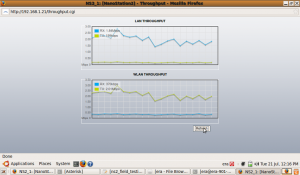
Screenshot of Nanostation 2 bandwidth testing at Old Wolverton, displayed on Asus Eee PC running Ubuntu
Today we carried out our second set of field tests. This time using our new Ubiquity Nanostation2 wifi routers. In the morning Chris, Mark and John started with a radio site survey, then did a single wifi link of about 460 meters, and had a quick check of the video streaming software (mjpgstreamer) in one direction and a two-way voip call.
ERA: Portable VoWLAN project
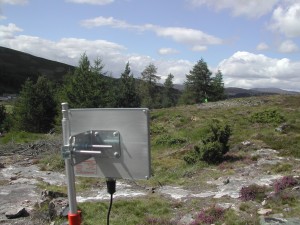 ERA (Enabling Remote Activity) is an Open University project that supports remote participation by students in field trips. Using a wireless network, digital stills and video cameras, and two way audio communications, students are able to gather data and interact with colleagues in remote locations.
ERA (Enabling Remote Activity) is an Open University project that supports remote participation by students in field trips. Using a wireless network, digital stills and video cameras, and two way audio communications, students are able to gather data and interact with colleagues in remote locations.
Thanks to a Rapid Innovation Grant from JISC we are investigating the potential use of Voice over Internet Protocol (VoIP) telephony to provide audio and video communication over a portable wireless network. This blog will be the place where we post details on the work being undertaken and our immediate findings.
More details to follow as the project gets going.
Related links
- ERA project website – for a general introduction to the project
- ERA project wiki – for technical details
- VoWLAN project blog – this blog site
